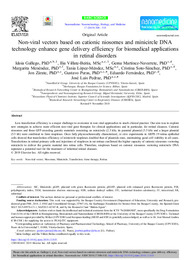Título :
Non-viral vectors based on cationic niosomes and minicircle DNA technology enhance gene delivery efficiency for biomedical applications in retinal disorders |
Autor :
Gallego , Idoia
Villate Beitia, Ilia 
Martínez-Navarrete, Gema
Menéndez, Margarita
López-Méndez, Tania
Soto-Sánchez, Cristina 
Zárate, Jon
Puras, Gustavo
Fernández, Eduardo
Pedraz, José Luis  |
Editor :
Elsevier |
Departamento:
Departamentos de la UMH::Histología y Anatomía |
Fecha de publicación:
2019-04-17 |
URI :
https://hdl.handle.net/11000/34590 |
Resumen :
Low transfection efficiency is a major challenge to overcome in non-viral approaches to reach clinical practice. Our aim was to explore
new strategies to achieve more efficient non-viral gene therapies for clinical applications and in particular, for retinal diseases. Cationic
niosomes and three GFP-encoding genetic materials consisting on minicircle (2.3 kb), its parental plasmid (3.5 kb) and a larger plasmid
(5.5 kb) were combined to form nioplexes. Once fully physicochemically characterized, in vitro experiments in ARPE-19 retina epithelial
cells showed that transfection efficiency of minicircle nioplexes doubled that of plasmids ones, maintaining good cell viability in all cases.
Transfections in retinal primary cells and injections of nioplexes in rat retinas confirmed the higher capacity of cationic niosomes vectoring minicircle to deliver the genetic material into retina cells. Therefore, nioplexes based on cationic niosomes vectoring minicircle DNA represent a potential tool for the treatment of inherited retinal diseases.
|
Palabras clave/Materias:
non-viral vector
niosomes
minicircle
transfection
gene therapy
retina |
Tipo de documento :
info:eu-repo/semantics/article |
Derechos de acceso:
info:eu-repo/semantics/openAccess |
DOI :
10.1016/j.nano.2018.12.018 |
Publicado en:
Nanomedicine . 2019 Apr:17:308-318 |
Aparece en las colecciones:
Artículos Histología y Anatomía
|

 La licencia se describe como: Atribución-NonComercial-NoDerivada 4.0 Internacional.
La licencia se describe como: Atribución-NonComercial-NoDerivada 4.0 Internacional.
.png)